Reproductive Health Chapter Notes | Biology Class 12 - NEET PDF Download
Introduction
- Reproductive health refers to the state of having healthy reproductive organs that function normally. However, it goes beyond just physical health to encompass emotional and social aspects of reproduction as well.
- According to the World Health Organization (WHO), reproductive health means overall well-being in all areas of reproduction, including physical, emotional, behavioral, and social aspects.
- Maintaining reproductive health is crucial for ensuring that individuals have functioning reproductive organs and can engage in healthy emotional and behavioral interactions related to reproduction.
- A society with people who have physically and functionally normal reproductive organs and positive emotional and behavioral interactions in sex-related matters can be considered reproductively healthy.
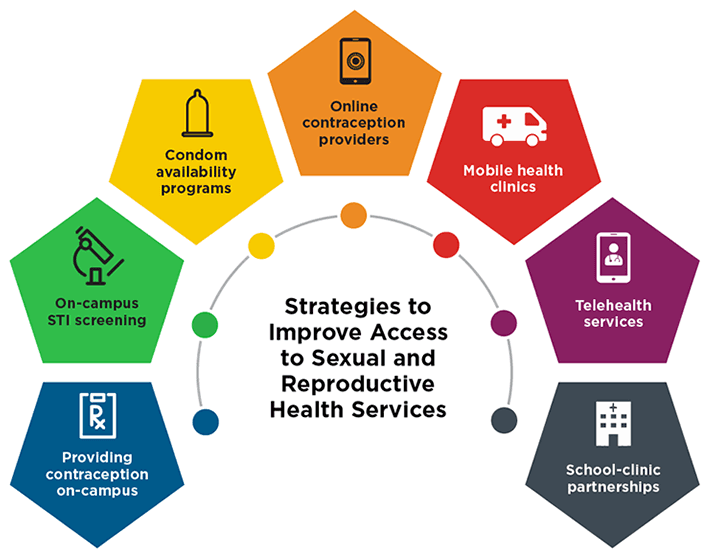
Reproductive Health – Problems and Strategies
India was one of the first countries to take action towards achieving total reproductive health as a social goal. The government started family planning programmes in 1951, which have evolved into the current Reproductive and Child Health Care (RCH) programmes. These programmes aim to create awareness and provide facilities for a reproductively healthy society.
Creating Awareness and Educating People
- Governmental and non-governmental agencies use audio-visual and print media to raise awareness about reproductive health.
- Parents, relatives, teachers, and friends also play a crucial role in spreading information.
- Sex education in schools is encouraged to provide accurate information and dispel myths about sex-related topics.
- Teaching about reproductive organs, adolescence, sexual practices, and sexually transmitted diseases (STDs) helps adolescents lead healthy lives.
- Fertile couples and those of marriageable age need to be informed about birth control options, care for pregnant mothers, and post-natal care for mothers and children.
- Emphasizing breastfeeding, equal opportunities for male and female children, and the impact of uncontrolled population growth is crucial.
- Awareness of social issues like sex abuse and sex-related crimes is necessary for building a responsible society.
Implementation and Infrastructure
- Successful implementation of reproductive health plans requires strong infrastructure, professional expertise, and material support.
- Medical assistance for issues like pregnancy, delivery, STDs, abortions, contraception, menstrual problems, and infertility is essential.
- New techniques and strategies should be introduced for better care.
- Statutory bans like the prohibition of amniocentesis for sex determination help combat female foeticide.
- Child immunization and other programmes contribute to reproductive health.
Research and Development
- Governmental and non-governmental agencies support research in reproductive health to develop new methods and improve existing ones.
- An example is the development of 'Saheli', an oral contraceptive for females by scientists at the Central Drug Research Institute (CDRI) in Lucknow, India.
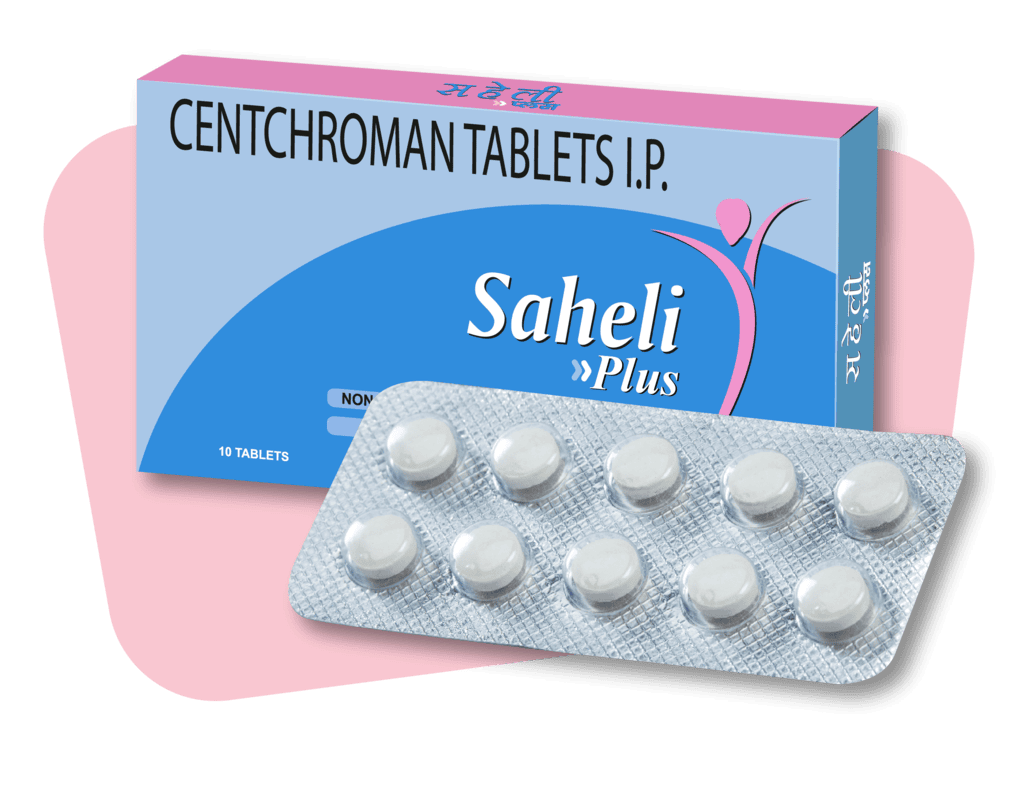 Saheli (Oral Contraceptive)
Saheli (Oral Contraceptive)
Indicators of Improved Reproductive Health
- Increased awareness about sex-related matters.
- Higher rates of medically assisted deliveries and better post-natal care, leading to decreased maternal and infant mortality rates.
- Smaller family sizes and improved detection and treatment of STDs.
- Overall improvement in medical facilities for all sex-related issues.
Population Stabilisation and Birth Control
Population Stabilisation
In the past century, advancements in various fields have significantly improved people's quality of life. However, better health facilities and living conditions have also led to explosive population growth. The world population, which was around 2 billion in 1900, surged to about 6 billion by 2000 and 7.2 billion in 2011. India experienced a similar trend, with its population increasing from approximately 350 million at independence to nearly a billion by 2000 and surpassing 1.2 billion in May 2011.
Factors Contributing to Population Growth
- Decline in Death Rates: There was a rapid decline in death rates, including maternal mortality rate (MMR) and infant mortality rate (IMR).
- Increase in Reproductive Age: The increase in the number of people in reproductive age contributed to population growth.
Government Measures
- The government implemented measures to control the population growth rate.
- According to the 2011 census, the population growth rate was less than 2 percent (20 per 1000 per year), which could still lead to rapid population increase.
- This growth rate posed a threat of scarcity in basic necessities like food, shelter, and clothing, despite progress in these areas.
Strategies for Population Control
- The government promoted smaller families through various contraceptive methods.
- Campaigns like "Hum Do Hamare Do" (We Two, Our Two) encouraged couples to limit their children.
- Many urban, working couples adopted an "one child norm."
- The legal marriageable age was raised to 18 for females and 21 for males.
- Incentives were offered to couples with small families.
Birth Control (Contraceptives)
Ideal Characteristics of Contraceptives: User-friendly, Widely available, Highly effective, Reversible, Minimal or no side effects, No interference with sexual drive, desire, or the sexual act
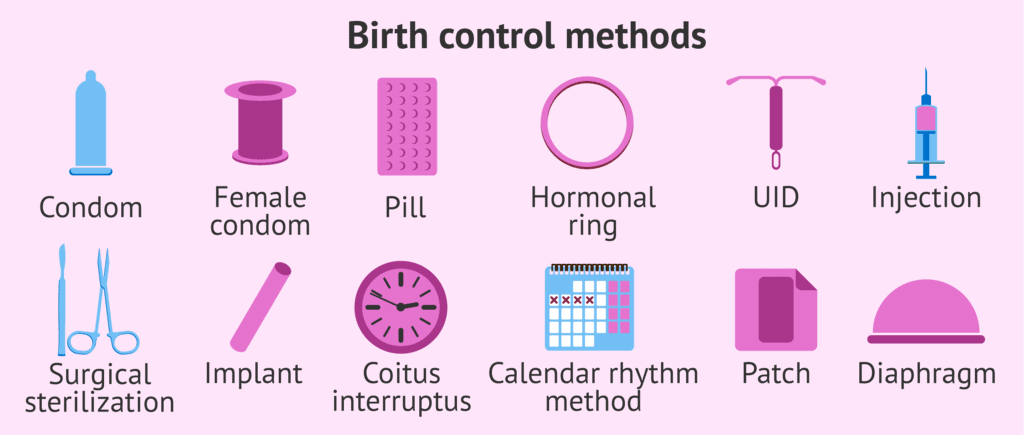 Birth Control Methods
Birth Control Methods
Categories of Contraceptive Methods
- Natural/Traditional Methods
- Barrier Methods
- Intrauterine Devices (IUDs)
- Oral Contraceptives
- Injectables & Implants
- Surgical Methods
1. Natural Methods of Contraception
(i) Periodic Abstinence
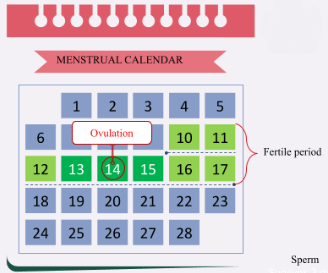 Menstrual Calender
Menstrual Calender
- Definition: Periodic abstinence involves avoiding sexual intercourse during the fertile period of the menstrual cycle to prevent conception.
- Fertile Period: The fertile period is typically from day 10 to day 17 of the menstrual cycle when ovulation is expected. During this time, the chances of fertilization are very high.
- Method: Couples abstain from coitus during the fertile period to reduce the likelihood of sperm meeting the ovum and achieving fertilization.
(ii) Withdrawal Method (Coitus Interruptus)
- Definition: The withdrawal method, also known as coitus interruptus, involves the male partner withdrawing his penis from the vagina just before ejaculation to prevent insemination.
- Mechanism: By withdrawing before ejaculation, the male partner aims to prevent sperm from entering the female reproductive tract and fertilizing the ovum.
(iii) Lactational Amenorrhea Method
- Principle: The lactational amenorrhea method is based on the natural suppression of ovulation during the period of intense lactation following childbirth.
- Mechanism: During exclusive breastfeeding, ovulation and the menstrual cycle are temporarily suppressed, significantly reducing the chances of conception.
- Duration: The lactational amenorrhea method is considered effective for up to six months after childbirth, as long as the mother breastfeeds the child exclusively.
Advantages of Natural Methods of Contraception:
- No side effects since no medicines or devices are used.
- Natural methods are generally safe and do not interfere with the body's natural processes.
Disadvantages of Natural Methods of Contraception:
- Higher chances of failure compared to other contraceptive methods.
- Reliability may vary based on individual circumstances and adherence to the methods.
2. Barrier Methods of Contraception
Barrier methods of contraception involve preventing the meeting of ovum and sperm through physical barriers. These methods are available for both males and females and include various devices designed to block the entry of sperm into the female reproductive tract.
(i) Condoms
 Condoms
Condoms
- Condoms are thin rubber or latex sheaths used to cover the penis in males or the vagina and cervix in females just before intercourse.
- They prevent the ejaculate from entering the female reproductive tract, thereby reducing the chances of conception.
- 'Nirodh' is a well-known brand of male condom.
- Condoms have gained popularity not only for contraception but also for protecting against sexually transmitted infections (STIs) and HIV/AIDS.
- Both male and female condoms are disposable, can be self-inserted, and offer privacy to the user.
(ii) Diaphragms, Cervical Caps, and Vaults
- These are rubber barriers inserted into the female reproductive tract to cover the cervix during intercourse.
- They prevent conception by blocking sperm from entering through the cervix.
- Diaphragms, cervical caps, and vaults are reusable.
(iii) Spermicidal Creams, Jellies, and Foams
Spermicidal products are often used in conjunction with barriers like diaphragms and cervical caps to enhance their contraceptive effectiveness.
3. Intrauterine Devices (IUDs)
IUDs are a popular and effective method of contraception.They are inserted into the uterus by healthcare professionals, such as doctors or trained nurses, through the vagina.
Types of IUDs
(i) Non-medicated IUDs: Example includes the Lippes loop.
(ii) Copper-releasing IUDs: Examples include CuT, Cu7, and Multiload 375.
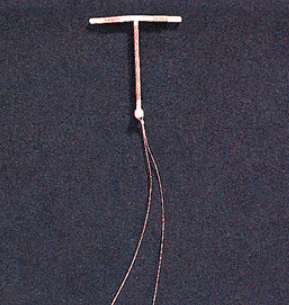 Copper T (Cu T)
Copper T (Cu T)
(iii) Hormone-releasing IUDs: Examples include Progestasert and LNG-20.
How IUDs Work
- IUDs enhance the phagocytosis of sperm within the uterus.
- Copper ions released from the IUDs inhibit sperm motility and fertilizing capacity.
- The hormone-releasing IUDs also make the uterus inhospitable for implantation and the cervix hostile to sperm.
Benefits of IUDs
- IUDs are ideal for women who wish to delay pregnancy or space out their children.
- They are widely accepted and used as a method of contraception in India.
4. Oral Contraceptive Pills
Oral administration of small doses of progestogens or progestogen–estrogen combinations is another contraceptive method used by females. These pills are taken in the form of tablets and are popularly known as contraceptive pills.
Usage and Effectiveness
- Pills are taken daily for a period of 21 days, preferably starting within the first five days of the menstrual cycle.
- After a 7-day break(during which menstruation occurs), the cycle is repeated until the female desires to prevent conception.
- Pills work by inhibiting ovulation and implantation, as well as altering the quality of cervical mucus to prevent or delay the entry of sperm.
Saheli: Saheli is a new oral contraceptive for females that contains a non-steroidal preparation. It is a once-a-week pill with very few side effects and high contraceptive efficacy.
5. Injections and Implants
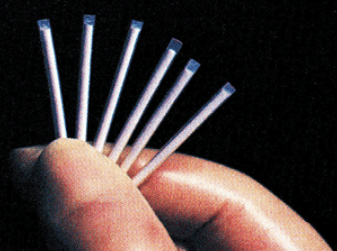 Implants
Implants
- Progestogens, either alone or in combination with estrogen, can be administered through injections or implants placed under the skin.
- Their mode of action is similar to that of oral contraceptive pills, but the duration of effectiveness is significantly longer.
Note:
The administration of progestogens, progestogen-estrogen combinations, or Intrauterine Devices (IUDs) within 72 hours of intercourse has proven to be highly effective as emergency contraceptives.These methods can be used to prevent potential pregnancy resulting from incidents such as rape or casual unprotected intercourse.
6. Surgical Methods of Sterilization
Surgical methods, also known as sterilization, are permanent procedures recommended for individuals who wish to prevent any further pregnancies. These interventions block the transport of gametes, thereby preventing conception.
Vasectomy (Male Sterilization)
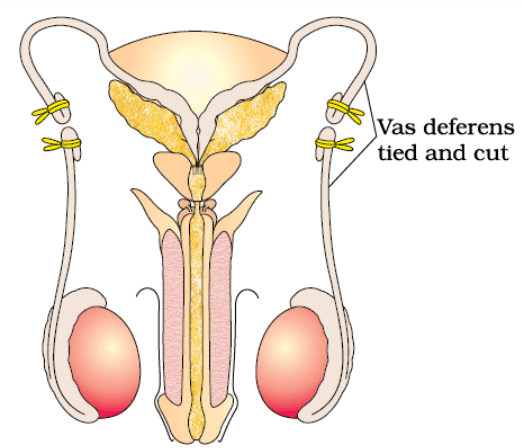 Vasectomy (Male Sterilisation)
Vasectomy (Male Sterilisation)
- Procedure: A small section of the vas deferens is either removed or tied off through a small incision in the scrotum.
- Effectiveness: Vasectomy is highly effective in preventing pregnancy.
- Reversibility: The procedure is not easily reversible.
Tubectomy (Female Sterilization)
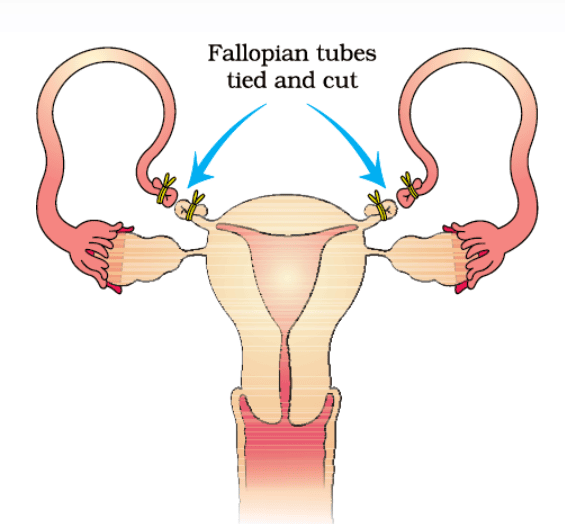 Tubectomy (Female Sterilization)
Tubectomy (Female Sterilization)
- Procedure: A small section of the fallopian tube is removed or tied off through a small incision in the abdomen or vagina.
- Effectiveness: Tubectomy is also highly effective in preventing pregnancy.
- Reversibility: Like vasectomy, tubectomy is not easily reversible.
Consultation with Medical Professionals For Contraceptives
- It is crucial to select and use a suitable contraceptive method in consultation with qualified medical professionals.
- Contraceptives are not regular requirements for maintaining reproductive health but are used to prevent, delay, or space pregnancies due to personal reasons.
- The widespread use of these methods plays a significant role in controlling population growth.
Possible Side Effects of Contraceptives
- Although not very significant, potential side effects such as nausea, abdominal pain, breakthrough bleeding, irregular menstrual bleeding, or even breast cancer should not be entirely ignored.
Medical Termination of Pregnancy (MTP)
Medical termination of pregnancy (MTP), also known as induced abortion, refers to the intentional or voluntary termination of pregnancy before full term. Globally, around 45 to 50 million MTPs are performed annually, accounting for about one-fifth of all conceived pregnancies each year. The acceptance and legalization of MTP remain subjects of debate in many countries due to emotional, ethical, religious, and social concerns. In India, the government legalized MTP in 1971 under strict conditions to prevent misuse, particularly to curb illegal and indiscriminate female foeticides, which are prevalent in the country.
Reasons for MTP
- MTP is often sought to terminate unwanted pregnancies resulting from: Unprotected intercourse, Contraceptive failure & Rape.
- MTP is also necessary in cases where continuing the pregnancy could pose significant risks or be fatal to the mother, the fetus, or both.
Safety and Risks
- MTP is generally considered safe during the first trimester, up to 12 weeks of pregnancy.
- Second-trimester abortions carry higher risks.
Illegal Practices and Misuse
- A concerning trend is the prevalence of illegal MTPs performed by unqualified individuals, which pose serious health risks and can be fatal.
- Another dangerous practice is the misuse of amniocentesis to determine the sex of the unborn child. If the fetus is identified as female, MTP is often carried out, which is illegal and harmful.
Prevention and Awareness
- Effective counseling on the importance of protected intercourse and the risks associated with illegal abortions is crucial.
- Improving healthcare facilities and access to safe abortion services can help mitigate these unhealthy trends.
Sexually Transmitted Infections (STIs)
Infections or diseases that are transmitted through sexual intercourse are called sexually transmitted infections (STIs), venereal diseases (VD), or reproductive tract infections (RTI). Some common STIs include:
- Gonorrhoea
- Syphilis
- Genital herpes
- Chlamydiasis
- Genital warts
- Trichomoniasis
- Hepatitis-B
- HIV leading to AIDS
Transmission and Danger of STIs
- HIV infection is the most dangerous STI and is discussed in detail in Chapter 7.
- Infections like hepatitis-B and HIV can also be transmitted by sharing contaminated needles, surgical instruments, blood transfusion, or from an infected mother to the fetus.
Cure and Symptoms of STIs
- Except for hepatitis-B, genital herpes, and HIV infections, other STIs are completely curable if detected early and treated properly.
- Early symptoms of STIs are often minor and include itching, fluid discharge, slight pain, swellings, etc., in the genital region.
- Infected females may be asymptomatic and remain undetected for a long time.
Complications and Social Stigma
- The absence or minority of symptoms in the early stages, along with the social stigma attached to STIs, can deter infected individuals from seeking timely detection and treatment.
- Delayed treatment can lead to complications such as pelvic inflammatory diseases (PID), abortions, stillbirths, ectopic pregnancies, infertility, or even cancer of the reproductive tract.
Prevention and Vulnerability
- STIs pose a significant threat to public health, and therefore,prevention, early detection, and treatment are prioritized in reproductive health care programs.
- While anyone can contract STIs, the incidence is particularly high among individuals aged 15-24 years.
- Avoid sexual intercourse with unknown partners or multiple partners.
- Always use condoms during sexual intercourse.
- If in doubt, consult a qualified doctor for early detection and complete treatment if diagnosed with an infection.
Infertility
- Infertility is a significant aspect of reproductive health, affecting many couples worldwide, including in India. It refers to the inability to conceive despite regular unprotected sexual intercourse.
- The causes of infertility can be varied, including physical, congenital, disease-related, drug-induced, immunological, or psychological factors. In many cases, the problem lies with the male partner, despite societal tendencies to blame the female.
- Specialized healthcare units, such as infertility clinics, can assist in diagnosing and treating some of these disorders, enabling couples to conceive. When natural conception is not possible, couples may turn to assisted reproductive technologies (ART) for assistance.

In Vitro Fertilization (IVF) and Embryo Transfer (ET)
- IVF is a common ART method where fertilization occurs outside the body under laboratory conditions. Ova (eggs) from the female partner or a donor and sperm from the male partner or a donor are collected and combined to form a zygote.
- The zygote or early embryos (up to 8 blastomeres) are then transferred into the fallopian tube or uterus, depending on their development stage. This process is also known as the test tube baby program.
Other ART Methods
- Zygote Intra Fallopian Transfer (ZIFT): In this method, the zygote or early embryo is transferred into the fallopian tube.
- Intra Uterine Transfer (IUT): Embryos with more than 8 blastomeres are transferred into the uterus.
- Gamete Intra Fallopian Transfer (GIFT): An ovum from a donor is transferred into the fallopian tube of another female who cannot produce ova but can support fertilization and development.
- Intracytoplasmic Sperm Injection (ICSI): A specialized procedure where a sperm is injected directly into an ovum to form an embryo.
- Artificial Insemination (AI): This technique is used when the male partner has difficulty inseminating the female or has very low sperm counts. Semen from the husband or a donor is artificially introduced into the vagina or uterus (Intra-Uterine Insemination or IUI).
Challenges and Considerations
- These advanced reproductive techniques require precise handling by specialized professionals and costly equipment, making them accessible only in a few centers in the country.
- The high cost and the emotional, religious, and social considerations can deter many couples from pursuing these options.
- Legal adoption remains a viable and compassionate alternative for couples seeking parenthood, especially given the number of orphaned and destitute children in need of care.
|
59 videos|290 docs|168 tests
|
FAQs on Reproductive Health Chapter Notes - Biology Class 12 - NEET
| 1. What are the main reproductive health problems faced globally? |  |
| 2. What strategies can be implemented to improve reproductive health? |  |
| 3. How does population stabilization relate to birth control methods? |  |
| 4. What are the legal and medical aspects of Medical Termination of Pregnancy (MTP)? |  |
| 5. What are the common causes of infertility and available treatments? |  |
















